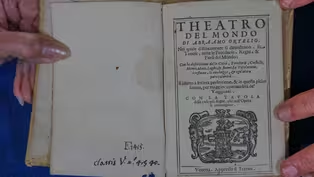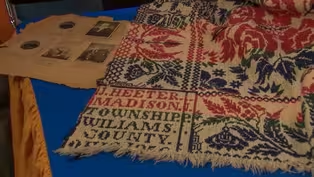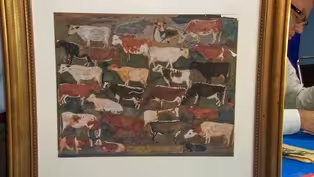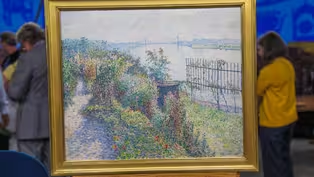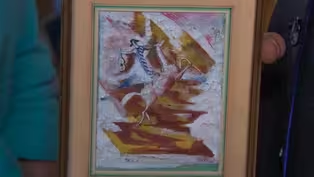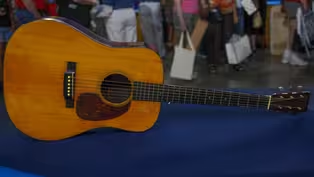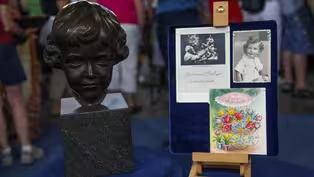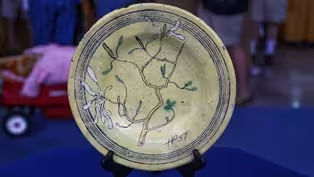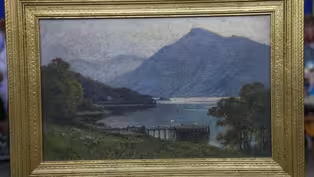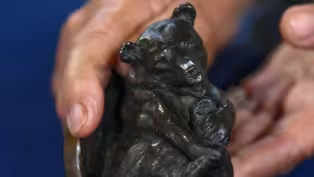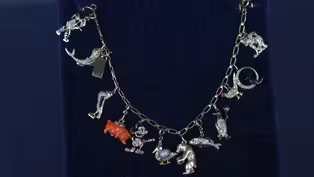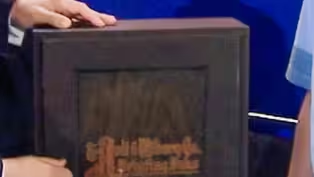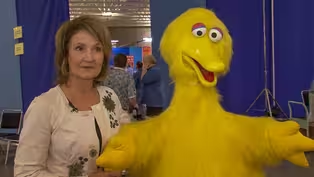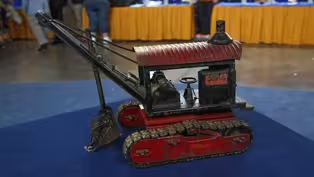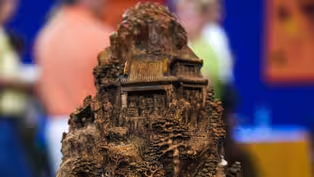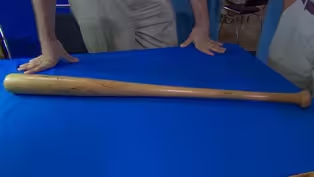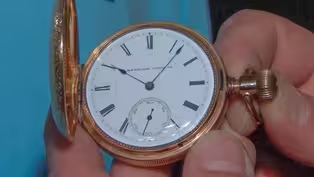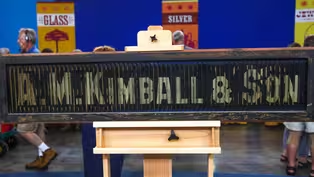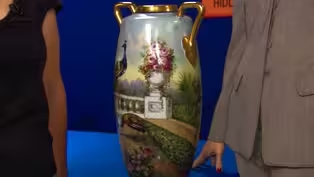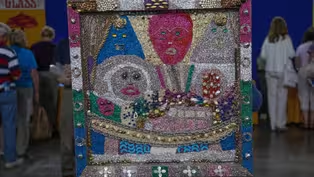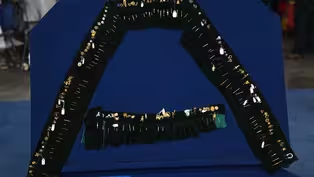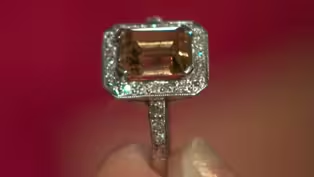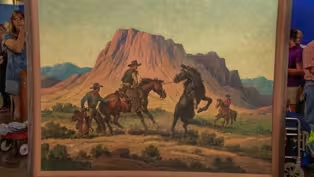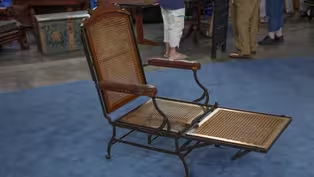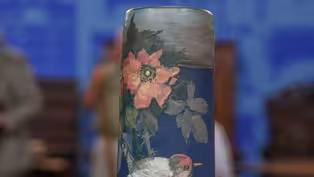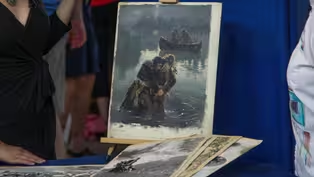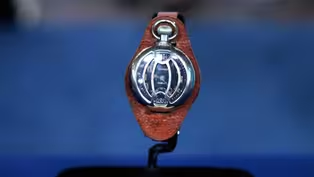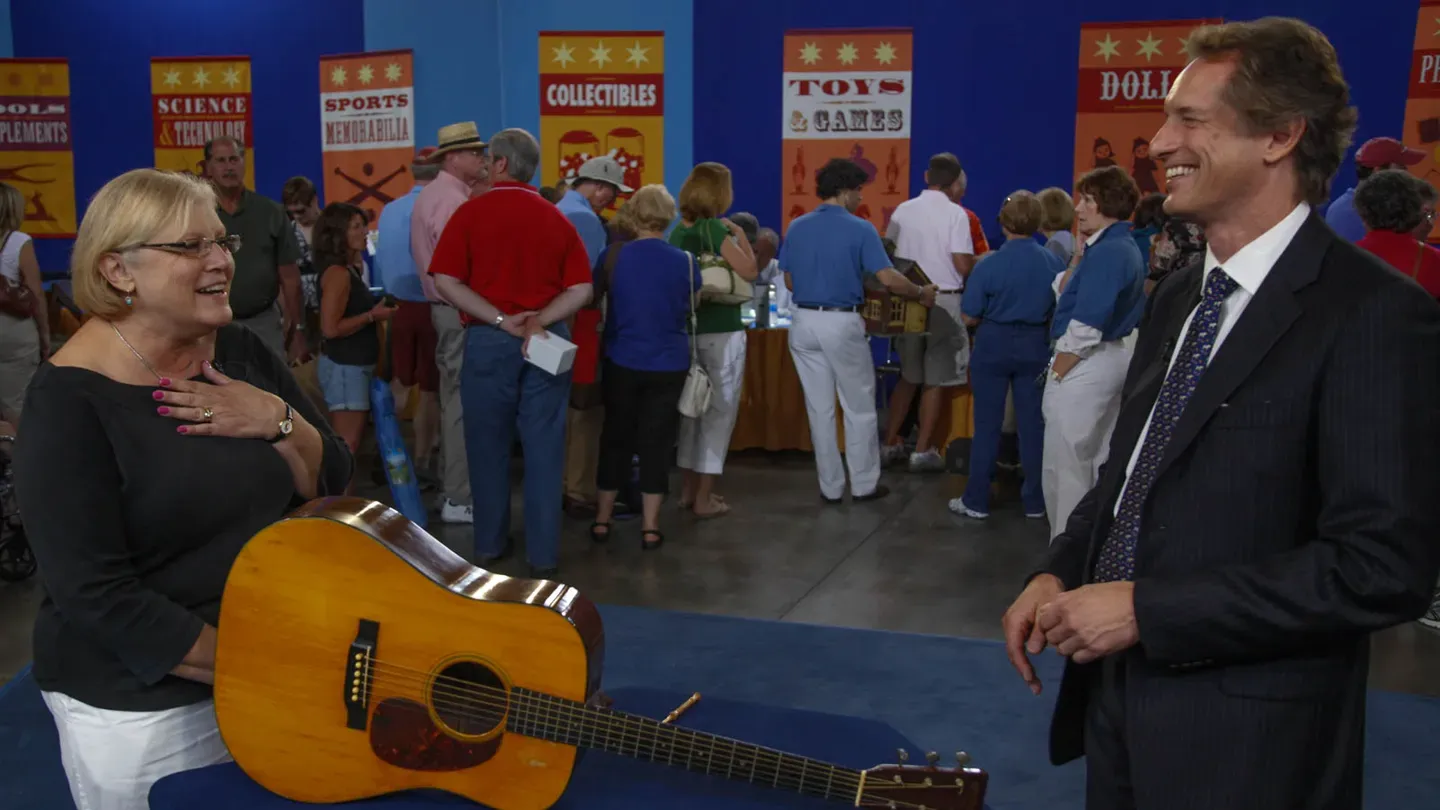

Vintage Madison 2024, Hour 1
Season 28 Episode 20 | 52m 25sVideo has Closed Captions
Learn how the antiques market has evolved since 2008. One find is now up to $150,000!
Learn how the antiques market has evolved since 2008. Highlights include a Hank Aaron-signed game-used bat, a stickpin collection, ca. 1900, and an 1893 Tiffany & Co. World’s Fair Exhibition vase. One find is now $100,000 to $150,000!
Problems playing video? | Closed Captioning Feedback
Problems playing video? | Closed Captioning Feedback
Funding for ANTIQUES ROADSHOW is provided by Ancestry and American Cruise Lines. Additional funding is provided by public television viewers.

Vintage Madison 2024, Hour 1
Season 28 Episode 20 | 52m 25sVideo has Closed Captions
Learn how the antiques market has evolved since 2008. Highlights include a Hank Aaron-signed game-used bat, a stickpin collection, ca. 1900, and an 1893 Tiffany & Co. World’s Fair Exhibition vase. One find is now $100,000 to $150,000!
Problems playing video? | Closed Captioning Feedback
How to Watch Antiques Roadshow
Antiques Roadshow is available to stream on pbs.org and the free PBS App, available on iPhone, Apple TV, Android TV, Android smartphones, Amazon Fire TV, Amazon Fire Tablet, Roku, Samsung Smart TV, and Vizio.
Buy Now
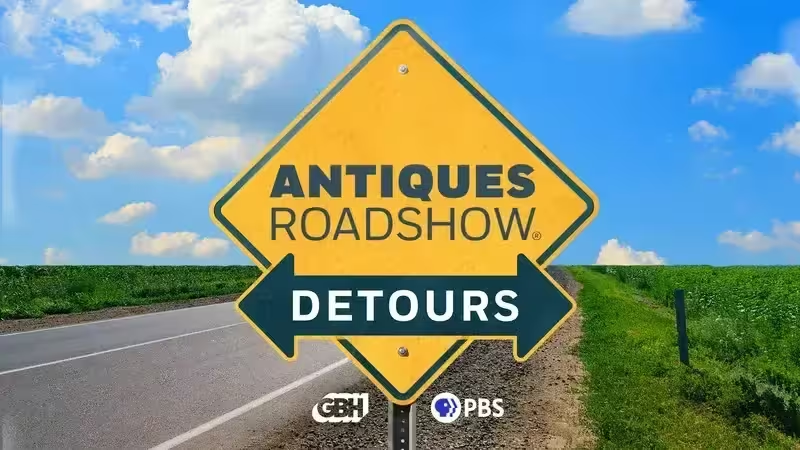
ANTIQUES ROADSHOW DETOURS
Ever wondered what happens to the treasures featured on America’s beloved ANTIQUES ROADSHOW after the cameras leave town? Host Adam Monahan tracks down the juicy afterlives of your favorite finds from PBS’s hit series.Providing Support for PBS.org
Learn Moreabout PBS online sponsorship♪ ♪ GUEST: We eventually did hang it in my son's bedroom, but he was scared of it, so we took it down.
(both laughing) Oh, my husband's gonna be so excited.
Oh!
APPRAISER: You like that?
Yes!
Thank you.
♪ ♪ CORAL PEÑA: When "Antiques Roadshow" visited Madison, Wisconsin 15 years ago, we were surprised to learn some of our guests didn't necessarily like their treasures.
He said, "Would you like to have these old Western pictures?"
"Yes, I guess so."
Then we found out that this had a radium face on it, and my grandmother wouldn't let us play with it anymore.
When you first came in, what did you tell me when you took it out of the bag?
(laughs) (laughing): I said it's ugly.
PEÑA: Now these objects are getting the "Vintage Antiques Roadshow" treatment.
Will the 2024 values make our guests appreciate their items more, less, or just about the same as they did in 2009?
Let's find out.
GUEST: This was my father-in-law's guitar.
And he purchased it from his brother, who was a professional musician.
I just know it's a 1938 Martin and he played it all the time.
He really enjoyed it.
He didn't really play much professionally.
He tried to do that.
I think in the '30s, there's a picture someplace of him with George Gobel.
Oh, really?
Yes.
He did make it onto the radio?
He did make it onto radio with George Gobel the one time.
He didn't give it a lot of hard playing, and, most importantly, he didn't have work done on it.
The D-18 model is probably the most sought-after model by bluegrass and folk players.
Oh, really?
They like the D-18 because it's a relatively simple guitar.
It doesn't have a whole lot of needless ornamentation.
And what they love about it is that the back and sides are made of mahogany, which-which is, acoustically... Oh... ...a very, very fine wood, even though it's not very showy.
So these actually, uh, work better with, uh, recordings and microphones.
Now, the front of the guitar is made from spruce that came from the Adirondack Mountains.
Really?
Inside the guitar, we have a stamp on the center strip that says "C.F.
Martin, Nazareth, Pennsylvania," and on the upper block, where the neck is actually set in, it will have the model number, which is D-18, and it will have the serial number, which we can date to late 1938.
And 1938 was a pivotal year for Martin, where they actually changed the bracing, the internal bracing on the guitar.
So I'm just gonna feel quickly right in here, and I feel that that "X" where the bracing crosses... Oh... ...is very near the sound hole.
So we call that "advanced bracing," which makes it a more valuable guitar.
Really?
Okay.
You've had some correspondence with the Martin Company to find out about the model number, but what you didn't find out was what it's actually worth.
Right.
Do you have an idea of that?
No, well, the letter said the new ones in the '60s were worth about $1,000.
Mm-hmm.
So we thought, well, maybe with inflation, about $5,000.
Okay.
Wa-- I need to... (stammering): 'Cause we'd like to insure it properly, and...
Okay.
The top has been overcoated lightly.
And that just means a clear coat of varnish... Oh, really?
To-to cover up some of the wear that's happened to it.
But that's not a big deal, because in today's market, the replacement value of this guitar, with the advanced bracing, would be about $28,000 to $30,000.
(gasps) Okay, uh... Yeah.
Wow.
(both laugh) Oh, my.
(laughs) He would be so proud.
It's such an honor for him, it really is.
He was such a great guy.
GUEST: A.M. Kimball & Sons is a general store that was in my hometown growing up.
It is no longer in business, but they had several buildings behind the general store that was used for many different things, like lumber and selling seeds, and they had an icehouse.
And those buildings behind the general store were bought by my parents.
And when they bought it, they were able to get all the contents, and this is where that sign came from.
Well, a general store back in the day, at the turn of the century, sold all kinds of things.
And this is a wonderful advertising sign that advertises Wrigley's chewing gum and Wrigley's Juicy Fruit gum at the same time, as well as the Kimball store.
These signs are called lenticulars.
What's great about Wrigley's is it is a 100-year-old company that sold baking powder.
And in order to induce people to buy more baking powder, they gave away a free stick of gum.
And guess what, a new business was made: Wrigley's chewing gum.
I would date this probably about 1915, 1920.
Advertising was fiercely competitive, even back in the turn of the century.
And they tried to make advertising tin signs that were bigger and better and more beautiful, and it really draws you in.
And this would be really appealing to an advertising collector.
In a good advertising auction, this would bring between $3,000 and $5,000.
Wow, that's fantastic.
GUEST (voiceover): Big Bird here was purchased about 20 years ago.
My daughter and I went to a garage sale.
There was Big Bird, Cookie Monster, and Oscar, same size.
And so she, of course, she wanted all three, and I said "if you could only have one," and we chose Big Bird.
I knew I'd get my $50 investment back, but nice to know that he's worth more than that.
GUEST: My grandparents emigrated from Norway in 1868.
And her cousins painted the cows on my grandmother's farm and mailed it to them after they were here.
APPRAISER: And it's our thought that it's painted on vellum.
Vellum, that's what the framer told me.
'Cause I wouldn't know vellum from Velcro, but.
(laughs) GUEST: The last year the Braves were in Milwaukee, my dad took me to a few games.
And after one of the games, I was standing on the dugout.
And the batboy came out and yelled at me for being on the dugout, so I hopped off the dugout.
And then he came back out and gave me Hank Aaron's broken bat, which he had used during the game.
After the game, we got it signed.
And as you can see here, we have a very faint signature, and then we have a much darker signature.
Where did you get that?
About 15 years after that, in 1978, the American Legion team from my hometown made it to the American Legion World Series.
And one of the players on that team won the batting championship.
Hank Aaron came to present the batting award, and when he was in town I had him sign my bat a second time.
This is a beautiful, picture-perfect, mid-1960s Hank Aaron game-used bat.
It's been cracked.
This was used in a game.
You can see the-the ball marks here, a real powerful hitter here.
And what's also cool, you have his number, 44, and the serial number here on the knob.
It's a beautiful, beautiful bat.
And, uh, I wouldn't insure it for anything less than $8,000.
(chuckles) (chuckling): $8,000?!
How about that?
GUEST: My grandmother was Norwegian, but one of her sisters married the artist, and I believe he was German.
But I don't know, really, anything about him.
What about the painting itself?
Do you know where that is?
It originally was in a very ugly yellow frame.
And when I had it reframed, we took off the back, and it said on the back, by the artist, "Dresden."
And that really is about all I know, the fact that the-the painter was related to me, so... And-and who was the painter?
B. Schrader, and I think he married my grandmother's sister, so it would be my great-uncle.
My father wrote on the back of the painting, too, that information, so that we'd always remember.
It does appear to be Dresden.
It's a beautiful painting.
It's a nice summer day, a beautiful garden.
And it's done in what we call a sort of pointillist style.
Mm-hmm.
This is where the artist used little dabs of color all through the, uh, the painting.
You can just look down in this area.
It's not just one color; you have this-this shadow here.
Yeah.
This purple shadow, but it's broken up into little lavenders, and some purples and ochres.
It brings a liveliness to it, the painting jumps out at you because of all these little breaks of color.
The thing about it...
I say this nice German view, and you have this family history, but I think you might want to take that back off afterwards and-and review it.
Okay.
So I've looked at this and I-I've looked at the name down here.
There is a B. Schrader who does pointillist works in Dresden.
Okay.
Except it's not your uncle.
Okay.
Or great-uncle.
It's a Bertha Schrader.
It's a woman artist.
Okay.
Wow.
Who, uh, lived from 1845 to 1920 and practiced in Dresden and did views of the Elbe, and this is very much her style.
I think it's a fabulous painting.
And the fact that it's just so alive, just so colorful.
Um, I think it could stand a slight cleaning.
If you look at it, there's some surface dirt on there.
Have you ever had it valued, when you had it framed, at all?
I-I haven't had it appraised, but I had an appraiser come to my house to look at another painting that we had who-- that I thought was valuable.
And he looked at that and said, "Oh, it's really not worth anything."
And he turned around and saw this on my wall and said, "That, however, really should be in a period frame, "not in this ugly yellow frame.
And it's actually worth more money."
But he said without being able to research the artist, he didn't know how much.
There are very few records for this artist-- it's not a household name, even in Germany-- about ten records.
I would give an auction estimate of $20,000 to $30,000 for this.
Wow.
I have seen others that have come up for auction-- which are not as nice as this-- have made in the $30,000 range.
Wow.
So I can see with an estimate of $20,000 to $30,000, I can see it surpassing that if this were to go to auction.
That's wonderful.
I had no idea that it was that valuable.
GUEST: I brought in a little metal bear that was my great-grandfather's.
And this was given to me by my uncle, who came to visit me at one time while I was a zookeeper, and enjoyed his trip so much and thought I would appreciate the bear.
I know it's by Anna V. Hyatt, but I really don't know much about the artist, nor when it was done.
Okay, well, it's a wonderful bronze.
What's so nice about it is its size.
It's such a tactile object.
And it's signed, "Anna V.
Hyatt."
She's also better known as Anna Hyatt Huntington, with her married name.
Oh!
And she was actually one of America's most, um, prolific sculptors of the 20th century and one of the really very prominent women sculptor who paved the way for a lot of others to gain their own success.
Um, she was born in 1876 in Cambridge, Mass.
Oh.
And her father was actually a professor at Harvard of, uh, paleontology and zoology.
Oh, how interesting.
And that was, I think, what really sort of got her interested in animals.
Quite a bit of her sculpture relates to animal subjects.
She did this bear, um, jaguars, and lions and tigers and elephants.
Just right up my alley.
And all kinds... All kinds of animals.
Yeah.
And she really seemed to have a, you know, an amazing sense of, um, being able to capture the movement in the animal.
Right.
And this is a very playful subject matter.
Yes, it is.
Playing with his toes, or you know, bear cub on its back.
There are some other markings.
It actually has the markings of the foundry where it was cast, which was the Gorham Foundry in Providence, Rhode Island.
Oh, that's what that is.
Okay.
And they actually were one of the sort of mainstays.
They produced many, many bronze castings.
And this is actually number four of this model out of, I think, I believe 138 that were cast by them.
Oh.
And it probably dates from about 1910.
Oh, really?
So one of her earlier works.
She was very successful in her time.
Um, she married quite late in life.
She married the philanthropist Huntington when she was in her late 40s.
Mm-hmm.
She had an amazingly long career.
She was active for more than 70 years.
Oh, my word.
So she worked throughout her entire life, and I think her last works were done when she was in her 90s, so she was, um... Oh, my word!
So she was obviously very passionate about, about the work that she did.
She died in 1973.
A very well regarded artist who has quite a body of work.
I would think for insurance purposes, you want to think in the figure at around $5,000.
Okay.
Oh, that's wonderful.
Thank you so much.
GUEST: My father was in the Army after World War II, he was stationed in Japan.
And every week he would get his rations, which cost two dollars and included a carton of American cigarettes.
He would take the cigarettes to a little store and sell them for Japanese yen.
And he would get about $12 to $14 in yen, depending on the week.
So, one week he took them in and, in turn, he bought this for what he got for his carton of cigarettes.
This is bamboo.
This was designed to be put on a table for the scholar to contemplate, to look at.
And what it depicts is a congregation of scholars at this monastery that's perched in the mountain itself.
And they are engaged in conversation and walking, and you can see pine trees, and the very heavily cut and carved work here.
They carved under all the way through.
We can even see, at one point, scholars sitting at a table, which looks like a table of rock.
And they're sitting and perhaps playing a game.
There are also mountain goats.
And very close there, you can see some cranes.
Now, this was a section of bamboo that's very thick.
Very unusual to find one this thick.
Because it's so heavy and thick, it has cracked, but that doesn't affect the piece.
It's fine that way.
We don't see these much.
It's extremely unusual.
And we think it maybe dates later in the Qing Dynasty, 19th to the beginning of the 20th century.
Today in the auction market, we think this should bring between $10,000 and $15,000.
Oh, my gosh.
Wow.
(laughs) Wow.
(chuckles) I need to take good care of it.
(chuckles) GUEST: My husband's mother started the collection.
This is basically hers.
We've added to it.
APPRAISER: Right.
When she passed away, we found them in the safe deposit box and didn't realize there were that many of them.
And my husband really liked it, so we decided we would continue the collection.
Well, it's definitely the largest collection of stick pins I've ever seen in one-one place.
Oh.
I picked out a few different examples.
Um, most of them are English and American, late 19th, early 20th century.
You have an enamel dog here in 14-karat yellow gold.
You have gold dog's head here in 14-karat yellow gold.
These are both American.
This one here, you have a enameled flower with a little old-mine diamond in the center, and a little enameled lily of the valley stick pin here.
And then this piece up here is a diamond-set grouse, which is English, about 1890.
Do you have any idea of the values that you have here?
I checked online for some of the prices, and when we averaged 'em out and timed it how many we had, we figured we would average them to about $200 apiece, which would make it about somewhere between $20,000 and $25,000.
Right.
So.
We came to a price of approximately $500 apiece.
Ooh!
Uh, and it's quite a conservative price that we're putting on them.
Oh, my!
But, uh, in a retail environment... (softly): Oh.
...we give the retail price of around $60,000.
Oh!
There are certainly a few here which are certainly far more than $500.
And there are a few, I'm afraid, which are a little bit less.
Right.
But, on-on average, $500 is a conservative price.
Oh!
You like that?
Yes!
Thank you.
Oh, no, thank you for bringing them in.
It's, uh...
It's been great fun.
My husband will be so excited, and my mother-in-law had such exquisite taste.
It's signed in the lower right and dated 1922.
Serge Férat was a Russian Cubist artist.
This work is probably a Cubist fantasy.
There's an alligatoring surface to the gouache.
As is, the value is about $2,500 to about $3,000.
Oh my goodness.
(chuckles) If it were in perfect condition it could be $7,000, $8,000.
Oh my goodness.
Unfortunately, in the '70s, my father was cleaning out the attic and threw out the base cause he thought it was ugly.
And when he passed away, it became mine.
Handel was a company in Meriden, Connecticut.
Made this sort of lamp in the early part of the 20th century.
They started in the late 19th century.
I think the good news is that the shade alone is probably a $4,000 to $6,000 shade, but if you had the base, it would probably be double that.
Wow.
Okay.
So, $8,000 to $12,000 for the lamp.
Oh, my goodness.
It's kind of a shame, but we don't know how elaborate or how good the base was.
GUEST: I got it at a flea market outside of Chicago in the '80s, and I paid $200.
Well, I think you'll be delighted to know this artist is Tillman Parker Goodan, He's a well-known Western artist.
He was an authentic cowboy, rodeo performer, before he became an artist.
His works are known for their extraordinary authenticity.
And a picture like this, in this market, would sell for about $7,000 to $10,000 at auction.
Really?
Yes.
Very exciting.
Thank you very, very much.
I'm thrilled to see it.
Wow.
Thank you for coming.
It's terrific, thank you.
GUEST: It was originally my grandfather's.
He got it during World War I, and being first-generation German descent, they wouldn't give him any firearms, and he bought this as a, uh, memento piece, since he couldn't keep, like, a firearm or anything.
It's my understanding that he bought it at the PX of Fort Dixon in Iowa.
I believe it was 1915.
He never talked about it.
He put all his stuff in a box, basically, and it pretty much stayed there until the grandkids started rummaging through things, and then we found out that this had a radium face on it and my grandmother wouldn't let us play with it anymore.
So I haven't seen it for probably 30 years.
This watch would have been made in 1915.
Prior to the First World War, it was very unusual for gentlemen to wear wristwatches.
They would always wear pocket watches.
And the idea of a man wearing a piece of jewelry was very much frowned upon.
It was only really when the war started that they found in the trenches and in-in combat, the practicalities of having a pocket watch... uh, it-it was very difficult.
So the men actually designed a way to strap their pocket watches onto their wrists.
All right.
Now, here we have a very classic example, where a manufacturer has basically adapted that idea.
This watch is effectively a pocket watch that's been modified to be strapped onto a piece of leather with a protective guard over the dial.
Another aspect taken from the First World War was this type of black enamel dial.
Most enamel dials were made in white.
The black, obviously, anti-reflective and much better for-for nighttime, and far less chance of being seen from that point of view.
It's actually advertised on the box as having radium.
Right.
The radium has now gone brown, but it was originally a very bright glow that allowed them to glow in the dark.
And it really wasn't harmful to individuals.
Uh, the harmful part was to the poor people that were painting the dials.
They were actually painted by hand.
Uh, and you'd have these young ladies that would use a paintbrush, if you imagine, and lick the end of the paintbrush...
Yes.
Dip it into the radium...
I've heard that story before.
Write-write the numerals, and then, at the end of each one, lick again, back into the radium.
Very, very dangerous.
Now, this particular example remained in very good condition.
If you can imagine, most military examples that were made simply were destroyed or brought back, given to the kids.
Yup.
Its main interest is, historically, the fact that it was one of the very first-ever wristwatches.
Also, the condition, and that it still has the original box with it.
Value-wise, if it were to sell at auction today, you'd be looking at a number around $1,000.
Okay.
I'm pleasantly surprised, considering that the price on the box is $4.50.
(laughs) Some increase in the value over the years, yes.
Yes, it was.
GUEST: It was originally my father-in-law's.
He got it in about 1921, '22.
He was about one or two years old.
And when he died in about 1996, his wife gave it to my husband, his son.
APPRAISER: Well, Buddy Ls were made out of the same gauge steel that automobiles were made out of because they started off the company in Moline Pressed Steel making automotive fenders.
And then his son, Bud, had toys that just didn't last, so Mr. Lundahl decided to make some toys out of the same gauge steel that they used in the automobiles.
They made a lot of toys over the years.
One of their most popular toys is a steam shovel.
Oh.
They sold thousands of them, and it's the perfect toy for a child because it had a lot of action, can scoop up dirt, take it outside, have a lot of fun.
So there's lots of steam shovels.
Okay.
And the average Buddy L. steam shovel will sell for somewhere between $150 to $350, depending on the condition.
Mm-hmm.
Then they decided to make what they called an improved steam shovel.
Ah.
They put this very complex gearing system, a piston system, and the extra gears that would actually, when they operated, would move the shovel back and forth as opposed to just swinging.
Okay.
And their improved shovel is fairly rare.
The improved shovels, in average condition, can bring about $700 or $800.
Wow.
And then at some point... and I'm not so sure that the 1921 date... Is-is right?
...that your father-in-law got it, because I think this came out a little bit later.
Okay.
And that's when they started putting some toys on treads.
The treads were a very complex mechanism and they would go over any kind of surface.
They could go back and forth.
They just made the toy more real.
Of course, the problem is...
Yes.
(straining): ...it made the toy even heavier.
It's really heavy.
I don't know exactly what their production run was on this improved steam shovel on treads, but I did a little research and the last two that sold in 2006 and 2007, which were average examples and maybe a tad worse in some cases than this one, sold for in excess of $6,000.
Wow.
I think this one would probably do the same, even in today's market.
Oh, my gosh.
It's a real treat to see it.
It's only the first one I've ever seen in person and I'm glad you schlepped this all the way over here.
Thank you so much.
Oh, my husband's gonna be so excited.
I came by these illustrations from my uncle, and his father had them, and he was Czechoslovakian, came over when he was 16 years old.
And my uncle just had these out in his garage, and he said to me one day, he said, "Would you like to have these old Western pictures?"
I said, "Well, yes, I guess so.
I'll take those for the grandsons."
So that's how I acquired them.
And his father, I don't know how he acquired them, but he was chief editor of the Czech newspaper in Omaha, Nebraska.
And I did a little research on the Internet... Yeah?
...and found out that this gentleman, uh, Zdenek Burian, is from Czechoslovakia, the Moravian county.
Well, it's a terrific collection.
Burian was sort of a... somewhat of a prodigy.
He was born in 1905, went to the academy in Prague and, by the 1920s, the mid-'20s, he was already really pretty successful illustrator.
He started doing, uh, magazines and periodicals, but very quickly moved on, as you said, to Robert Louis Stevenson.
He worked for Zane Grey, illustrating all sorts of English language pieces as well as Czech works.
And these would have been created in the late '20s or early 1930s.
This is actually an oil that's been painted onto illustration board.
This sort of has some pluses and minuses to it.
As a medium, oil is generally the most desirable of media.
It's sort of seen as the most important to work in.
So an oil by an artist tends to have more value.
Having said that, this also does have some minor drawbacks.
The first is its condition.
In the hair of the figure here, we can see there's a pattern of crackle... Mm-hmm.
...right in the texture of the paint.
So that little bit of damage does hurt it slightly.
Mm-hmm.
The other issue is subject matter.
On the one hand, this was probably an illustration for a very interesting story.
On the other hand, as an object to live with, the subject matter is a little bit tough to live with.
We're in the middle of, let's face it, a death scene.
There's no getting around it.
Yes.
And many people don't really want to necessarily look at that as subject matter.
When we take all those factors into account, we're looking at about... at auction, about $2,000 to $3,000 for the oil.
Mm-hmm.
Now, in contrast, I've just picked out a couple of other highlights from the collection.
The first is this gouache that we're looking at up here.
It's a color gouache.
Gouache is just opaque watercolor.
But the fact that it's color as an illustration certainly keeps it very interesting.
The colors are very crisp.
The figure himself is just magnificent.
He's contemplative.
So he's got a lot going for him.
You're probably looking at about $1,000 to $1,500 for the color gouache.
Now, over here, this is actually a gouache in grisaille.
All that means is, in tones of gray.
This is going to be a little bit less desirable, but it's also still very saleable, and the subject matter here is fantastic.
We've got this wonderful setting, the drama of the rushing water.
We do have the inscription here at the bottom.
It's in Czech.
I'm not fluent.
It says, "He looked for her all through the night."
So this would have been the caption from the book... Mm-hmm.
...and this would have been the page number where it would have been placed.
Wow.
What you're looking at at auction for this particular work would be about $800 to $1,200.
And if you were to sell the whole group at auction, you'd probably be looking at about $8,000 to $10,000 for the bunch.
Wow!
GUEST: It belonged to my great-grandmother, and I know it's probably from the '20s.
And I know it says "Tiffany & Company" on the side.
The ring is made by Tiffany, but they never sold your great-grandmother this diamond.
Oh!
She had the diamond.
Oh!
If it was a Tiffany diamond... Mm-hmm.
...that they sold it to her, they would sign it inside.
Okay.
The price on this one here, in today's market, is somewhere between $20,000 and $25,000.
Oh, my God!
(laughs) Do you wear it?
Never, no.
Aw, come on!
I'm terrified to lose it.
(laughs) I got this coverlet from my father when I got married, and it's a, a family heirloom.
Well, this is wonderful.
We see so many of these Jacquard-woven coverlets on the "Roadshow."
We know the weaver was in your family, and we know him, which is such a wonderful, rare thing to have.
I would insure yours for somewhere between $1,000 and $1,200.
Ah, that's wonderful.
It's a salesman cabinet for printing inks, and it's Ault & Wilburg.
One of the more famous ink manufacturers of the turn of the century.
Uh, and where did you get it?
It was from my next-door neighbor.
He was a printer for a long time.
When he died, his wife offered it to me, and, uh, I just gave her $25 for it.
Twenty-five dollars.
Well, you know, I'm really a poster specialist.
Uh-huh.
Not a, an ink specialist.
But if we open this up, we see that as the salesmen went from shop to shop, they had their samples of inks to offer for sale.
But inks alone are not enough to really sell a product.
And what I found so fascinating about this piece is, tucked into the side of the box, very much like your insurance in your, in your car's glove compartment...
Right.
...is, basically, the sample book that goes with all of the inks.
And contained within the sample book are some works by very famous American artists.
One of them is Will Bradley, perhaps the most famous American Art Nouveau artist, very influential in the Arts & Crafts movement.
We also have great works by other artists really highlighting how good the inks are.
But in fact, it was a little bit of a misleading book, because to achieve this kind of level, uh, really took artistic talent, not ink, uh, quality.
Although the Ault & Wiborg Company really did make quality inks.
Do you have any idea of the value of this purchase of yours?
Well, I thought maybe just because of the book, it was, would be worth maybe $1,000.
Well, I think that's actually very close by a fraction of half.
I think the value for the case and the inks, it'll be between $800 and $1,200.
Uh, and I think the book I would value between $1,000 and $1,500.
Oh, that's what's worth...
Uh, bringing the total value of the whole package to, uh, $1,800 to $2,700 for the group.
Wonderful.
(laughing) Not bad for 25 bucks.
(laughing): No, not at all.
GUEST: We have an old little book that was found at a farmstead auction here in Wisconsin.
Now, when you bought it at the farm sale, what made you buy this particular book?
It was in a small box of a lot of old-looking papers.
Um, there was a deed that had an old date on it, and it was just a little book, and it was interesting because it had those little worm infestation marks, and it survived that.
A lot of books, the pages are missing or gone or stained.
This one didn't seem to be that way.
Well, when you bought that box of papers and so on, what'd you pay?
Seventeen dollars.
First of all, this is the original vellum binding.
This is in really good condition, but let's get to what it is.
It's by a man named Ortelius.
He lived in the 1500s.
In around the 1570s, he was the first one to actually put out what we would recognize as an atlas.
He was appointed by the king of Spain, he went all through Europe.
But he was the first atlas maker.
In the book, it has what's called a half-title.
Many times, this page is missing.
Yeah, you do have a few worm holes, but those are really minor and s, insignificant.
The next thing that, I know that you had pointed out to me was what the date was.
It's right here, 1655.
Now, that does tell something about the book, because Ortelius died in the late 1500s.
So 1655 is a later edition.
The first edition was 1570s, but then they kept adding more maps.
And some of the editions are huge.
We'd have trouble fitting them on this table.
But this was sort of like the paperback edition.
And then, the last thing we have on the book is the index, and many times, that's missing.
The condition looks wonderful.
The ink stock, there's a little bit of browning.
There's only been two or three records of sale of this particular edition in the last 20 years.
The most recent record was about 15 years ago.
It was missing that half-title page, it was missing the index, it had some tears in it, and that sold at a little over $2,000.
I think this one would sell in the $4,000 to $6,000 range in a retail store.
It's a great book.
And then you could put, put it in your pocket and you can travel through Europe and you'll know exactly where you're going.
(laughs) And right now, I just should be concerned with getting the little book back home.
(both laugh) GUEST: My aunts and uncles had a farm near New Paltz, New York, and it's alleged that my Aunt Kitty worked for one of the Rockefellers in New York, and the note that came with this said it may be a gift from him to her.
I got it from my mother, who got it from my aunt, maybe in the '30s, would be my guess, so...
Which Rockefeller?
Uh, my speculation would be John D., but I don't know for sure.
Okay.
This is something that was just so cute and so wearable.
You have 13 charms.
It's on a 14-karat white gold bracelet.
The charms are platinum with diamonds, and some of them have enameling on it.
There are four charms on here by a New York designer named Raymond Yard.
We have the fish, the bird, the penguin, and the cat.
Extremely collectible, very desirable, well-made charms.
Other pieces that really interested me?
Mickey Mouse, and then we have the little pig.
The pig is carved coral.
He has a little diamond attachment at the top.
We believe him to be by Cartier.
In a well-advertised auction, especially with the Raymond Yard and the Cartier connections, I think we're looking at about $18,000 to $22,000.
Well, thank you.
It's a bit of a surprise to me, so...
I'm aghast, so... (chuckles) GUEST: Well, I know that this piece of artwork was created by a local Madison artist named Simon Sparrow.
He was a street preacher in Madison.
And that's actually what I remember him from as a child.
He used to stand in Library Mall in a big, blue robe and preach, um, outside, on the campus.
He was a customer of my father-in-law's service station on Park Street in Madison.
And one day, in the winter, his car had broken down and he had walked to the service station to ask my father-in-law to help him, and so he did.
My father-in-law didn't charge him anything, and he made this as a thank-you present.
Do you have any idea when he made this?
I think that it was probably made in the late '70s, maybe early '80s at the latest.
So, what do you think your father-in-law thought when he gave it to him?
Well, I'm sure he appreciated the gesture.
I know that it hung for a while in my in-laws' basement.
And when my husband and I bought our first house, it was sent over to our home.
Wasn't very thrilled about having it in the house.
We eventually did hang it in my son's bedroom when he was a baby, and it was over his crib.
But he was scared of it, so we took it down.
(both laughing) One of the things that makes this kind of folk art so interesting is that it affects everybody in different ways.
And most people in the business would refer to this as outsider art.
It's made from found objects.
And Simon Sparrow thought that he was a spiritual vessel that God talked through.
And he thought that his art and his spiritual message were one and the same, that this type of creation was sort of the essence of the human spirituality.
He was West African, and so a lot of the symbolism is African spirituality mixed up with Christianity and iconic images.
There's quite a bit of his work out there.
He worked in different mediums.
He worked in pastels, he worked in pencil and charcoal.
He's got all kinds of stuff on here.
He's got beads, and shells, and put stuff on it to make it shiny.
Mr. Sparrow died in 2000, and there's some of his work in the Minnesota Museum of Art.
And he was represented by a major gallery down in Chicago.
I would say a good auction estimate on this would be $6,000 to $8,000.
Wow.
And then I would just kind of stand back and let 'em fight over it.
That's great.
Are you guys gonna hang it in the house?
(sighs): Yeah, I don't know.
(both laughing) We might have to now.
GUEST: It belonged to my parents.
And my father was an art collector, mostly paintings.
But then later on, he became interested in ceramics, sculpture, and other mediums.
Now, I think he met Henry Varnum Poor somewhere.
Some of the artists he collected were friends of his.
They may have introduced him.
They have known him.
They may have helped him make the connection.
How'd you acquire it from your father?
Well, he gifted it to me, and he had three others that...
Both my brothers and my sister also received a plate.
They were totally different.
I mean, my sister's had a lot of browns in it.
And, uh, it wasn't as pretty as this one.
I really like mine the best.
Henry Varnum Poor was born in Kansas in 1888.
He fought in World War I.
Built his house in 1920 with his own hands.
It was part of the Arts & Crafts tradition from which he sprung, and started potting about that time.
And he potted until his death in 1970.
This piece is signed and dated '57.
Yeah.
Which is sort of in the middle of his career.
I, I've seen a fair amount of his work, and I have never seen this color before, this technique.
It's almost like enamel on a yellow background.
The glazing technique, it's more of a faience type, where there's a, a lighter-colored background that offsets the artwork, which is loosely contained within, uh, incised lines on the surface of the plate.
It does tend more towards the browns that you're talking about.
This is unusually pretty and colorful.
Poor tended to make utilitarian ware: cups, saucers, bowls, and plates.
He didn't make a lot of vases.
Consequently, in terms of valuing things, utilitarian pieces, for most potters, their works are devalued.
But in Henry Varnum Poor's work, it doesn't really affect pricing all that much.
Same thing where there's some flat chipping around the edges, because it is low-fire ware.
Just recently, three very important pieces of Poor's work were just donated and accepted by the Metropolitan Museum of Art in New York City.
So, he's getting quite a bit of recognition as a potter, even though he was primarily known as a painter.
As a painter, yeah.
But he was also an architect and a writer.
Oh, yes, yes.
I mean, he was a real Renaissance man.
If I were to see, at auction today, I would expect to see an estimate of at least $2,500 to $3,500, and probably $3,000 to $4,000.
(laughs) Even with the, even with the damage.
Oh, my gosh.
Well, I'm, I'm, I'm thrilled.
I'm absolutely thrilled.
This is the first time in 14 years I've seen a piece of Henry Varnum Poor's work here.
Really?
Yeah.
So I'm really delighted to see this.
Oh, well, thank you so much.
I'm really happy I brought it.
APPRAISER: The Keystone Watch Company went into business 1886.
GUEST: Wow.
Was out of business by 1891.
It actually came out of the Lancaster Watch Company.
What's unusual about this watch is, where you see the balance staff rocking and moving back and forth?
Yes.
There's a little window over it.
The original company, Lancaster, developed that as a dust-proof mechanism.
Not your everyday Keystone.
The way we refer to these pieces is, is china painting, which means that they were purchased originally as blanks and painted outside the factory.
This is a particularly large example.
Uh-huh.
It is a particularly showy example, which was done by the Rivir Studios.
Uh-huh.
Rivir existed between 1922 and 1930.
My family came over from Scotland, and this is a picture of Loch Lomond in Scotland.
And I think it reminded them of their home.
There was Alfred de Bréanski, Sr., Alfred de Bréanski, Jr. Now, it's generally recognized that Alfred de Bréanski, Sr., was the, the greater of the two artists.
And I probably don't have him, then, right?
(stammers): Well, uh... (laughing) (laughing): No, actually.
Uh, this is Junior.
Alfred, Jr., had a very similar style to his father and chose similar subjects, but there is quite a price differential between the two of them.
Of course.
For a, a de Bréanski, Sr., with the mist descending, the sun hitting the water at the side of the mountain in Scotland, those are in great demand, and those will make $30,000, $40,000, $50,000.
Wow.
Now, Junior is nowhere in that league.
And for a piece like this, I would expect it to fetch somewhere in the $3,000 to $5,000 range at auction.
Oh, that's fine.
I don't want to part with it, anyways, but that's perfectly fine.
I love the picture.
And you and I have a little secret, right?
Yes, we do.
Should we share it with everyone else?
What do you think?
I'm ready, yes.
Let's do it.
(mechanism clicks) (mechanism clicks) There you go.
Bring this back.
Voilà.
(both laugh) Where did you find this chair?
I found this chair at my friend's house about 12 years ago, and he was willing to sell it.
Okay.
And I had to have it, just because it was so interesting, it was so different.
I have used the chair and it's really comfortable.
Okay.
It looks like it would be harsh with the metal on the sides.
Yes.
It's very soft.
It's very comfortable.
And this does recline down so you can take naps.
We see Victorian furniture on the "Roadshow" quite a lot.
Mm-hmm.
This is a walnut crest with a beautifully carved little sunburst here, these flower petals, beautiful figured burl.
I love this molded arch and all these details, which are walnut, with this caned back and seat.
Mm-hmm.
And then you got leather arms.
Some of the unsung heroes, really, of Victorian design and Victorian furniture are some of the inventors... Mm-hmm.
...and the great genius that they had in engineering this convertible furniture.
And they would apply for patents to have the latest and the greatest type of furniture like this that would be made for, actually, a very wealthy public.
Mm-hmm.
These are pretty expensive at the time.
Mm-hmm.
And in the 19th century, when this was made, in 1876, this would have been pretty much the cat's meow to own.
You can not only adjust this footrest up... Mm-hmm.
...but it also, of course, goes down.
Right.
So, which is kind of great.
Yeah.
And it will go, literally, all the way.
Correct.
Let's put it all the way down in the back, if you don't mind.
(mechanism clicks) So, if you, if you want to, you can actually make this into a bed.
There are reclining chairs like this, these convertible chairs, that exist...
In, in the Metropolitan Museum of Art, they have one.
Oh, my goodness.
This shows the innovation of that period.
Mm-hmm.
That's how special they are.
I think it's made in New York.
A company named the Marks Company made very similar chairs.
There's this beautiful polychrome floral and pin-striped decoration that's totally original.
Mm-hmm.
The condition is unbelievable on this.
These are the original casters, which are mahogany.
Mm-hmm, mm, wow.
So it's a really high-quality, expensive caster.
This is the original leather upholstery.
So, you, you...
Yes, we haven't touched it.
How much did you, did you pay for the chair?
$400.
Okay.
The interest in this would probably come mostly from museums.
Right.
But I'd put an auction estimate on this piece of probably in the range of about $2,500 to $3,500.
Wow, wow.
Oh, that's incredible-- that's incredible.
GUEST: I got it from my uncle's aunt.
She lived in Chicago.
Okay.
That's about all I know about it.
Well, you know a little more.
You know who made it.
Yeah, it's on the bottom.
Yes, and what does it say?
Tiffany and Company.
And what else does it say?
Sterling silver...
Okay.
...and the letter T and some numbers.
Well, the letter T means it was made between 1891 and 1902, when Charles Tiffany was in charge of, of the production.
The first number is the, uh, pattern number, and the second is the order number for the piece.
It's very unusual, and not only is, is it sterling, but it has enamel on it-- beautiful enamel decoration.
Oh.
It's al, almost over the top, I have to admit that.
And then all of the, the stones are actually American stones.
They're American turquoise... Oh, really?
...and various other stones, plus the enameling.
Wow.
And, as I said, with the sterling mark.
You have no idea where she got it?
None.
But she lived in Chicago.
She lived in Chicago, right downtown, on, near the Midway Plaisance, which was part of the site of the Columbian Exposition.
So I don't know if that has anything to do with it or not, but... Now, when was the Columbian Exposition?
(sighs): 1893, I believe?
Okay, well, I think you've got a winner here.
This was made for the Columbian Exposition.
It was?!
Really?!
Yes.
Oh, my God.
By Tiffany.
(laughing) When you first came in, what did you tell me when you took it out of the bag?
I said, "It's ugly."
(laughing) Well, and I agreed with you.
You did.
But boy, the more I looked at it, the, I couldn't believe how wonderful it was, with all of these stones, and then to check the mark and everything.
It is absolutely spectacular.
(laughs) And when you turn it over, down here at the very bottom of the mark... Yeah?
...there is a globe with a T superimposed on it.
I saw the T. And a little tiny line in the middle that says "Tiffany."
And that was the exhibition signature... Oh, my God.
...for pieces in the World's Fair.
(exclaims) So, uh, your great-aunt must have had some very special friend that gave it to her... Wow.
...or, uh, one of her husbands, maybe?
(laughing): Maybe.
Okay, well...
There were s, there were several, yes.
There were several.
(laughing): Yeah.
Do you have any idea what it's worth?
Well, just because it's sterling, maybe $15,000?
If it was sterling, that's what it would be worth.
Mm-hmm.
But with all the enameling and everything else, an auction value on this piece in today's market, which is a little conservative, I would say $50,000 to $100,000.
Oh, my G... You're kidding.
No-- do you still think it's ugly?
(laughing): Yes.
Excuse me?
How much?
$50,000 to $100,000.
(laughing and crying): Okay.
But it's still ugly.
(both laughing) PEÑA: And now it's time for the "Roadshow" Feedback Booth.
We came to "Antiques Roadshow" to get away from home, to get away from our...
BOTH: ...significant others.
(laughs) And to make lots of money, which I didn't.
I didn't, either.
My boss gave me half a day off to bring his $30,000 or $40,000 Anthony Thieme painting down.
Turns out it's worth $30 or $40.
Thanks for the time off, Steve.
We discovered that when you come here and you're an Eagle Scout, you're not worth anything unless you're president.
And that a goofy hat collection is just a goofy hat collection.
We've had lots of fun with it today, because not many pitchforks were here.
And, uh, w, we got to protect ourselves and move the line along.
It worked well and had a great time.
Today at "Antiques Roadshow," we brought this ugly, yet potentially valuable, painting.
But thanks to "Antiques Roadshow," I just confirmed it's just ugly.
I brought this pig pitcher that my mom thought was too ugly.
So I thought it was great and it was appraised for between $200 and $400.
Wow.
(laughs) I got my Wisconsin beer case.
Uh, originally, it cost 60 cents.
I bought it for $15, and now apparently, it's worth $200 to $300.
And you know what?
When I got here, the beer case was full... (chuckles) But we had a great time at "Antiques Roadshow" in Madison.
Bye.
PEÑA: Thanks for watching.
See you next time on "Antiques Roadshow."
Appraisal: 1655 Ortelius Theatro Del Mondo Atlas
Video has Closed Captions
Clip: S28 Ep20 | 3m 12s | Appraisal: 1655 Ortelius Theatro Del Mondo Atlas (3m 12s)
Appraisal: 1856 Jacquard Coverlet
Video has Closed Captions
Clip: S28 Ep20 | 30s | Appraisal: 1856 Jacquard Coverlet (30s)
Appraisal: 1870 Folk Art Watercolor Painting
Video has Closed Captions
Clip: S28 Ep20 | 25s | Appraisal: 1870 Folk Art Watercolor Painting (25s)
Appraisal: 1910 Bertha Schrader Oil Painting
Video has Closed Captions
Clip: S28 Ep20 | 2m 47s | Appraisal: 1910 Bertha Schrader Oil Painting (2m 47s)
Appraisal: 1922 Serge Férat Gouache
Video has Closed Captions
Clip: S28 Ep20 | 38s | Appraisal: 1922 Serge Férat Gouache (38s)
Appraisal: 1938 Martin D-18 Guitar
Video has Closed Captions
Clip: S28 Ep20 | 2m 53s | Appraisal: 1938 Martin D-18 Guitar (2m 53s)
Appraisal: 1947 Albin Polasek Portrait Bust
Video has Closed Captions
Clip: S28 Ep20 | 1m 3s | Appraisal: 1947 Albin Polasek Portrait Bust (1m 3s)
Appraisal: 1957 Henry Varnum Poor Charger
Video has Closed Captions
Clip: S28 Ep20 | 2m 43s | Appraisal: 1957 Henry Varnum Poor Charger (2m 43s)
Appraisal: Alfred de Bréanski Jr. Oil, ca. 1930
Video has Closed Captions
Clip: S28 Ep20 | 1m 13s | Appraisal: Alfred de Bréanski Jr. Oil, ca. 1930 (1m 13s)
Appraisal: Anna Vaughn Hyatt Huntington Bronze, ca. 1910
Video has Closed Captions
Clip: S28 Ep20 | 2m 39s | Appraisal: Anna Vaughn Hyatt Huntington Bronze, ca. 1910 (2m 39s)
Appraisal: Art Deco Charm Bracelet, ca. 1935
Video has Closed Captions
Clip: S28 Ep20 | 1m 54s | Appraisal: Art Deco Charm Bracelet, ca. 1935 (1m 54s)
Appraisal: Ault & Wiborg Salesman’s Sample Case, ca. 1900
Video has Closed Captions
Clip: S28 Ep20 | 2m 11s | Appraisal: Ault & Wiborg Salesman’s Sample Case, ca. 1900 (2m 11s)
Appraisal: Big Bird Figure, ca. 1975
Video has Closed Captions
Clip: S28 Ep20 | 25s | Appraisal: Big Bird Figure, ca. 1975 (25s)
Appraisal: Buddy "L" Steam Shovel on Treads, ca. 1925
Video has Closed Captions
Clip: S28 Ep20 | 2m 55s | Appraisal: Buddy L Steam Shovel on Treads, ca. 1925 (2m 55s)
Appraisal: Chinese Bamboo Mountain Carving, ca. 1890
Video has Closed Captions
Clip: S28 Ep20 | 2m 17s | Appraisal: Chinese Bamboo Mountain Carving, ca. 1890 (2m 17s)
Appraisal: Hank Aaron-signed Game-used Bat, ca. 1965
Video has Closed Captions
Clip: S28 Ep20 | 1m 34s | Appraisal: Hank Aaron-signed Game-used Bat, ca. 1965 (1m 34s)
Appraisal: Keystone Watch Co. Pocket Watch, ca. 1890
Video has Closed Captions
Clip: S28 Ep20 | 29s | Appraisal: Keystone Watch Co. Pocket Watch, ca. 1890 (29s)
Appraisal: Lenticular Advertising Sign, ca. 1920
Video has Closed Captions
Clip: S28 Ep20 | 1m 48s | Appraisal: Lenticular Advertising Sign, ca. 1920 (1m 48s)
Appraisal: Rivir Studios China-painted Vase, ca. 1925
Video has Closed Captions
Clip: S28 Ep20 | 30s | Appraisal: Rivir Studios China-painted Vase, ca. 1925 (30s)
Appraisal: Simon Sparrow Mixed-media Art, ca. 1980
Video has Closed Captions
Clip: S28 Ep20 | 2m 50s | Appraisal: Simon Sparrow Mixed-media Art, ca. 1980 (2m 50s)
Appraisal: Stickpin Collection, ca. 1900
Video has Closed Captions
Clip: S28 Ep20 | 2m 9s | Appraisal: Stickpin Collection, ca. 1900 (2m 9s)
Appraisal: Tiffany Brown Diamond Ring, ca. 1920
Video has Closed Captions
Clip: S28 Ep20 | 35s | Appraisal: Tiffany Brown Diamond Ring, ca. 1920 (35s)
Appraisal: Tillman Parker Goodan Oil Painting, ca. 1925
Video has Closed Captions
Clip: S28 Ep20 | 54s | Appraisal: Tillman Parker Goodan Oil Painting, ca. 1925 (54s)
Appraisal: Walnut Reclining Chair, ca. 1876
Video has Closed Captions
Clip: S28 Ep20 | 3m 3s | Appraisal: Walnut Reclining Chair, ca. 1876 (3m 3s)
Appraisal: Weller Hudson Blue & Decorated Vase, ca. 1925
Video has Closed Captions
Clip: S28 Ep20 | 33s | Appraisal: Weller Hudson Blue & Decorated Vase, ca. 1925 (33s)
Appraisal: Zdeněk Burian Illustrations, ca. 1930
Video has Closed Captions
Clip: S28 Ep20 | 3m 41s | Appraisal: Zdeněk Burian Illustrations, ca. 1930 (3m 41s)
Appraisal: 1915 Ingersoll Military Wrist Watch & Box
Video has Closed Captions
Clip: S28 Ep20 | 3m 11s | Appraisal: 1915 Ingersoll Military Wrist Watch & Box (3m 11s)
Providing Support for PBS.org
Learn Moreabout PBS online sponsorship
- Home and How To

Hit the road in a classic car for a tour through Great Britain with two antiques experts.













Support for PBS provided by:
Funding for ANTIQUES ROADSHOW is provided by Ancestry and American Cruise Lines. Additional funding is provided by public television viewers.


